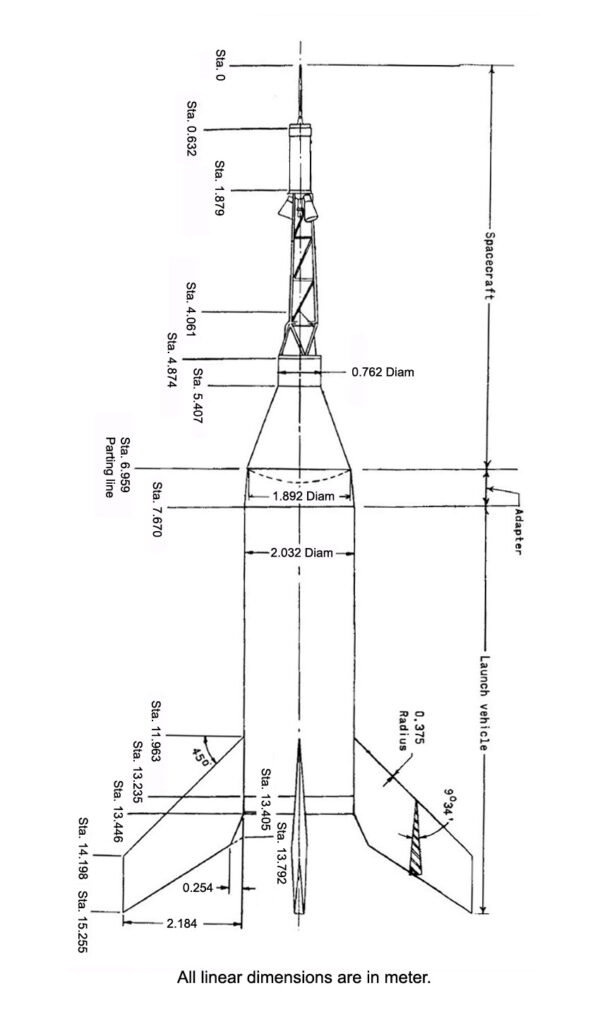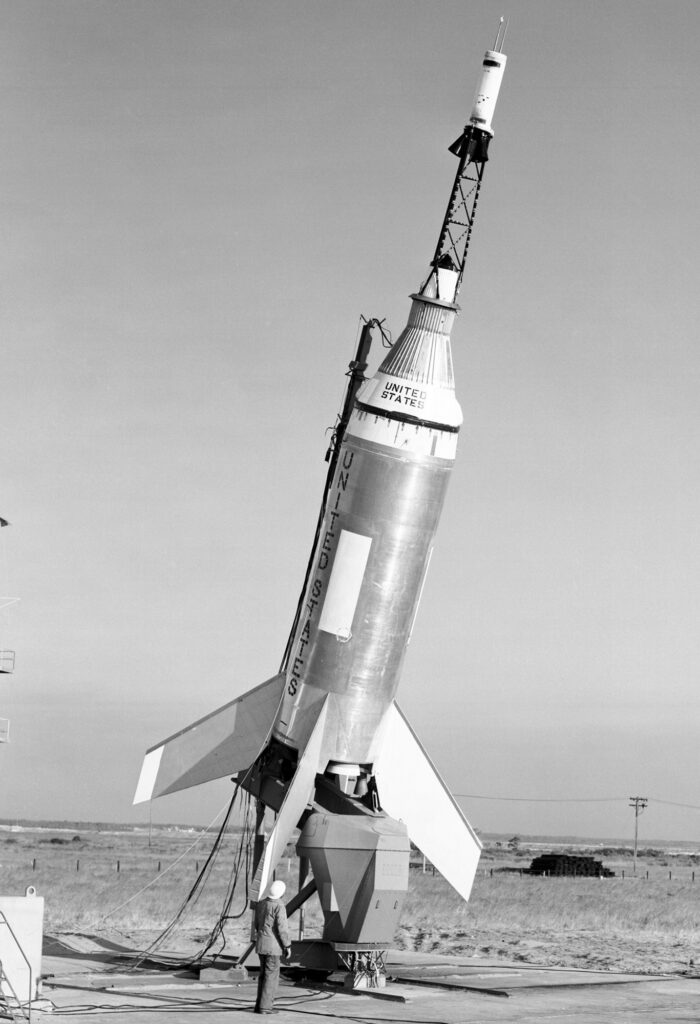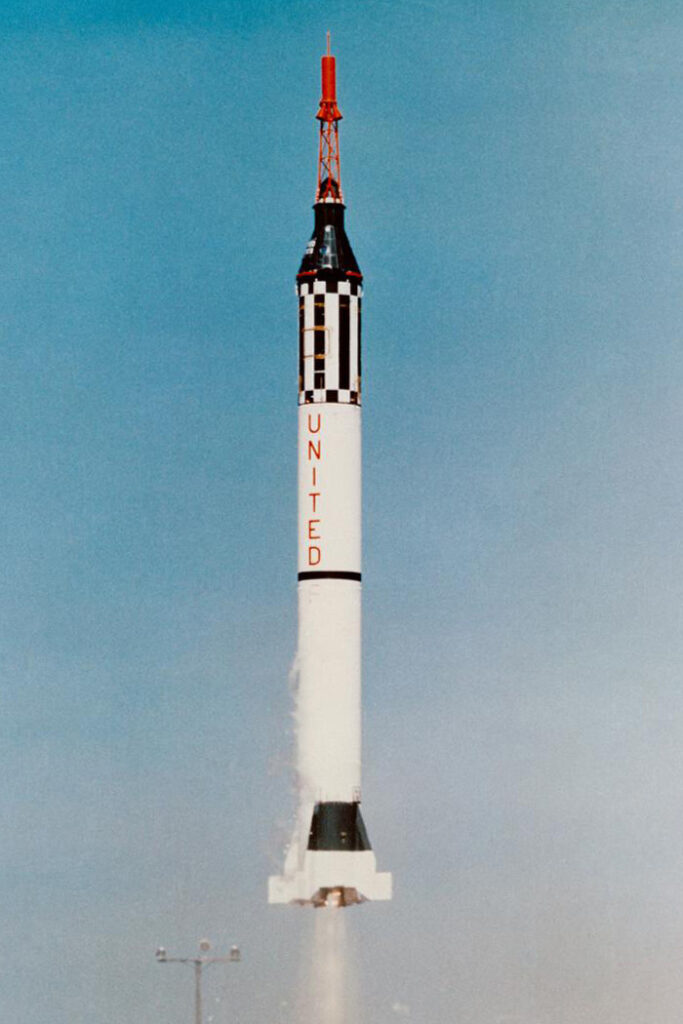The following launch vehicles were used as part of the Mercury program:

Little-Joe rocket
The Little Joe rocket was used to test the rescue system of the Mercury capsule. This was equipped with various combinations of four Recruit booster rockets and either two or four Castor or Pollux rockets.
| Mission | Rocket engines | Launch | Duration hr:min:sec |
Comment |
|---|---|---|---|---|
Mercury-Little-Joe 1 |
4 Pollux, 4 Recruit |
August 21, 1959 |
00:00:20 |
Failure |
Mercury-Little-Joe 6 |
4 Pollux, 4 Recruit |
October 4, 1959 |
00:05:10 |
Partially |
Mercury-Little-Joe 1A |
2 Pollux, 4 Recruit |
November 4, 1959 |
00:08:11 |
Partially |
Mercury-Little-Joe 2 |
4 Castor, 4 Recruit |
December 4, 1959 |
00:11:06 |
Successful |
Mercury-Little-Joe 1B |
2 Pollux, 4 Recruit |
January 21, 1960 |
00:08:35 |
Successful |
Mercury-Little-Joe 5 |
2 Pollux, 4 Recruit |
November 8, 1960 |
00:02:22 |
Failure |
Mercury-Little-Joe 5A |
4 Castor, 4 Recruit |
March 18, 1961 |
00:23:48 |
Partially |
Mercury-Little-Joe 5B |
4 Castor, 4 Recruit |
April 28, 1961 |
00:05:25 |
Partially |
The primary mission objectives for the Little Joe flights were to separate the Mercury capsule using the rescue rocket at maximum dynamic pressure, qualify the parachute system and verify search and recovery methods. The first flights were used to measure the flight and impact forces on the capsule. In later flights, critical parameters were to be measured at increasingly higher altitudes of 6 km, 76 km and 152 km. The minimum objectives of each Little Joe launch were supplemented from time to time by studies of noise levels, heat and pressure loads, heat shield distances, and animal behavior where the measurements could be made with minimal telemetry. Since all capsules powered by the Little Joe rockets were expected to be recoverable, onboard recording techniques contributed to the simplicity of the system.
All Little Joe rockets were launched from Launch Area 1 (LA-1) of the Wallops Flight Facility on Wallops Island in Virginia.
The original plan in the Mercury program was for all astronauts to conduct a training flight on a Little Joe rocket before their actual space flights. However, to accelerate the program, this plan was not implemented.
Redstone MRLV rocket
The Mercury-Redstone launch vehicle (Mercury-Redstone MRLV) was developed from the US Army’s military Redstone rocket for NASA’s Mercury project. The Mercury-Redstone launch vehicle was used for six suborbital Mercury flights.
| Mission | Launch | Mercury capsule (SC) | Launch vehicle (LV) | Duration hr:min:sec |
Comment SC / LV |
|---|---|---|---|---|---|
Mercury-Redstone 1 |
November 21, 1960 |
Capsule #2 |
MR-1 |
00:00:02 |
Failure |
Mercury-Redstone 1A |
December 19, 1960 |
Capsule #2A |
MR-3 |
00:15:45 |
Successful |
Mercury-Redstone 2 |
January 31, 1961 |
Capsule #5 |
MR-2 |
00:16:39 |
Succesful / Partially |
Mercury-Redstone BD |
March 24, 1961 |
Boilerplate |
MR-5 |
00:08:23 |
Succesful |
Mercury-Redstone 3 |
May 5, 1961 |
Capsule #7 |
MR-7 |
00:15:28 |
Succesful |
Mercury-Redstone 4 |
July 21, 1961 |
Capsule #11 |
MR-8 |
00:15:37 |
Partially / Succesful |
Because the Mercury-Redstone rocket had larger fuel tanks than the military Redstone rocket, an additional nitrogen bottle was added to pressurize the tank and, due to the longer burn time, an additional hydrogen peroxide tank was added to operate the turbopump.
The most significant change was the addition of an automatic in-flight abort detection system. In an emergency where the rocket was on the verge of catastrophic failure, an abort would activate the rescue rocket attached to the Mercury capsule. Either the astronaut or ground control could initiate an abort manually, but some possible errors during the flight could lead to a catastrophe before an abort could be initiated manually.
The Mercury-Redstone Automatic Flight Abort Detection System solved this problem by monitoring the rocket’s performance during flight. If it detected an anomaly, such as a loss of flight control, engine thrust or power, it automatically aborted, shutting down the engine and activating the capsule’s escape system.
Atlas-D rocket
The Atlas LV-3B, Mercury Atlas-D launch vehicle or Mercury Atlas launch vehicle was used to carry astronauts into low Earth orbit for the first time. In total, the USA launched the Mercury Atlas-D launch vehicle nine times.
| Mission | Launch | Mercury capsule (SC) | Launch vehicle (LV) | Duration hr:min:sec |
Comment SC / LV |
|---|---|---|---|---|---|
Mercury-Atlas 1 |
July 29, 1960 |
Capsule #4 |
50-D |
00:03:18 |
Failure |
Mercury-Atlas 2 |
February 21, 1961 |
Capsule #6 |
67-D |
00:17:56 |
Successful |
Mercury-Atlas 3 |
April 25, 1961 |
Capsule #8 |
100-D |
00:07:19 |
Failure |
Mercury-Atlas 4 |
September 13, 1961 |
Capsule #8A |
88-D |
00:49:20 |
Partially |
Mercury-Atlas 5 |
November 29, 1961 |
Capsule #9 |
93-D |
03:20:59 |
Partially / Successful |
Mercury-Atlas 6 |
February 20, 1962 |
Capsule #13 |
109-D |
04:55:23 |
Successful |
Mercury-Atlas 7 |
May 24, 1962 |
Capsule #18 |
107-D |
04:56:05 |
Successful |
Mercury-Atlas 8 |
October, 3 1962 |
Capsule #16 |
113-D |
09:13:11 |
Successful |
Mercury-Atlas 9 |
May 15, 1963 |
Capsule #20 |
130-D |
34:19:49 |
Successful |
The Atlas missile was manufactured by Convair and was a development of the SM-65D Atlas missile. Because the Atlas rocket was originally designed as a weapons system, it did not have the reliability required for manned missions. Therefore, Convair had to make significant efforts to make the rocket safe and reliable for manned Mercury-Atlas flights.
Changes to the Atlas were largely limited to those that improved astronaut safety. The standard D-series Atlas configuration was intended to be retained as much as possible, so various improvements to the latest Atlas rockets were not used. Although various equipment and processes used were outdated and often not the best or newest, they were preferred because they were tried and tested. Any new equipment or hardware changes made to the Atlas launch vehicles were required to be tested on at least three Atlas research and development flights before NASA approved them for use. Despite the conservatism and caution shown in the design, over the course of the program’s four and a half years, numerous changes occurred as a result of lessons learned, and the emphasis on quality control increased over time . The last two Mercury-Atlas flights underwent a level of testing and pre-flight inspections unheard of at the time of Big Joe’s flight in 1959.
All Atlas launchers were required to be complete and ready to fly upon delivery to Cape Canaveral, with no missing components or unscheduled modifications/upgrades. Following delivery, a comprehensive inspection of the Atlas was conducted and prior to launch, a flight review board was assembled to approve each Atlas as ready to fly.
NASA’s quality assurance program meant that each Mercury Atlas launch vehicle took twice as long to manufacture and assemble as an Atlas designed for unmanned missions, and three times as long to test and verify the flight.






